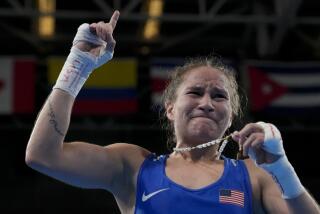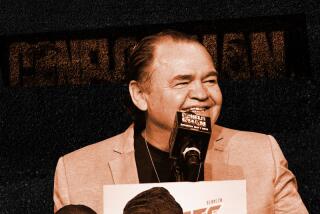Vasyl Lomachenko will use his fists and his mind against Jason Sosa
- Share via
The pattering of the speed bag, the grunts of a sparring session and the sweat from jumping rope are staple scenes of the boxing gym.
For Vasyl Lomachenko, there’s also the quiet time of an extended post-training chat with his sports psychologist.
The Oxnard-trained Ukrainian super-featherweight world champion, who returns to the ring Saturday night in an HBO-televised main event against Jason Sosa in Maryland, has relied on the unique program to produce impressive results.
Two Olympic gold medals. Two division belts in his first seven pro fights. And fists that strike with precision, power and speed.
“Athletes always try to improve, right? So I try to improve their psychological condition,” said Andriy Kolosov, a Ukrainian university-educated scientific researcher who’s assisted Lomachenko and stablemates Oleksandr Usyk, the unbeaten cruiserweight world champion, and light-heavyweight Oleksandr Gvozdyk (12-0, 10 KOs) since their Olympic days.
“A lot of psychological exercises can improve attention, memory, imagination, coordination,” Kolosov said. “Everything we do is made to add a little bit.”
Kolosov said he knows of no other boxers who consult frequently with an expert in the mentality of fighting.
Lomachenko (7-1, five knockouts) has certainly grasped the lessons while knocking out Roman Martinez to win the belt and forcing Nicholas Walters to quit last year en route to standing as a heavy favorite to dispose of Sosa (20-1-4, 15 KOs) at the new MGM resort outside Baltimore.
“Always in my training, every day, I try to be better,” Lomachenko, 29, said. “I train hard. I’m still growing up, trying to be the best. All your boxing skills depend on how your body’s feeling. If you’re strong, you can make what you want in the ring.”
“This is the professional way to prepare for the sport. It’s one of the best ways to prepare for a fight, to always have the psychologist by me. A professional athlete needs to train his body, but he, as well, needs to train his brain.
“It gives me results. It helps me to win the fights,” he said.
Kolosov said his lessons are built to balance the emotions of a fight with the intellect required to break down an opponent.
“You have some high emotional activity when you go through the ropes. And that high emotional activity can weaken intellectual activity. If you’re highly emotional, you lose muscle activity. That’s why we need to regulate cognitive and emotional activity,” Kolosov said.
“I give [Lomachenko] response and feedback, asking him, ‘How can we be better in order to become more confident? Understand [psychology] more. Be more stable. Emotional, but intellectual.
Lomachenko’s promoter, Bob Arum, is so captivated by his fighter that he’s said Lomachenko is his best since Muhammad Ali.
He’s watched Lomachenko spend 30 to 60 minutes in sessions with Kolosov after training, and the fighter’s father-trainer, Anatoly, and manager, Egis Klimas, are both strong advocates of the mental development.
“It’s terrific,” said Arum, calling the Eastern Europeans’ sessions an under-used preparation technique for all fighters. “I’ve never seen it before. They prepare differently from our Western fighters. They live their life differently. And that’s what really accounts for their amazing success. People have attributed it to their training program, and that’s part of it, but a lot of it is how they prepare and conduct themselves for fights.”
Twitter: @latimespugmire
More to Read
Go beyond the scoreboard
Get the latest on L.A.'s teams in the daily Sports Report newsletter.
You may occasionally receive promotional content from the Los Angeles Times.











